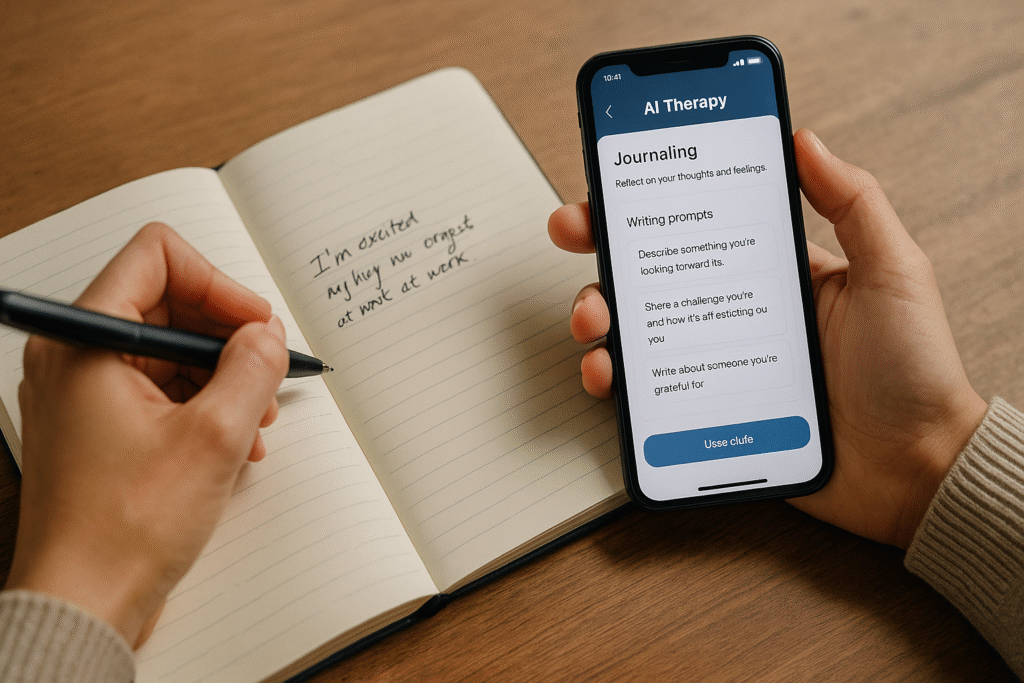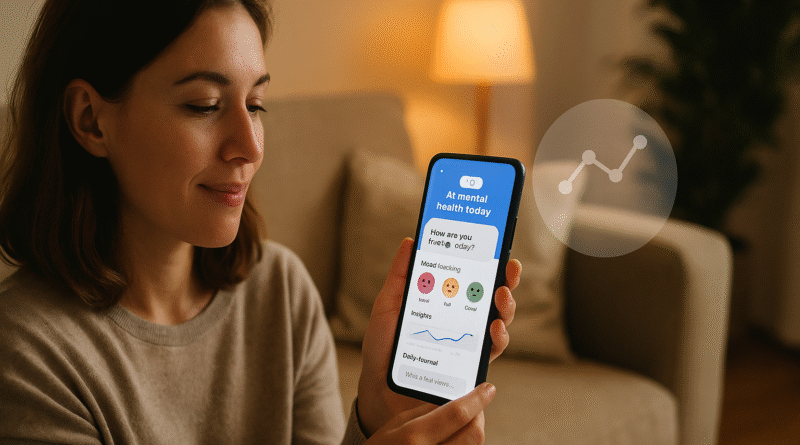8 Hidden Powerful AI Tools Revolutionizing Mental Health
Powerful AI Tools for Mental Health Introduction: The Quiet Revolution in Mental Health Support
Mental health has finally stepped into the spotlight, no longer a whispered conversation, but a critical part of public health, workplace policy, and personal well-being. Across Europe, the U.S., and Australia, campaigns have urged people to “open up,” employers are investing in mental health days, and influencers speak openly about burnout and anxiety. Culturally, we’re making progress.
But practically? Access is still broken.
Millions of people around the world still struggle to find affordable, timely, and consistent mental health care. Waiting lists for therapy can stretch months. In many rural or underserved regions, there are no mental health professionals available at all. And even when services are accessible, stigma, cost, and time often get in the way of people seeking the help they need.
That’s where artificial intelligence, quietly, steadily, is changing everything.
In 2025, a new class of AI-powered mental health tools is emerging. They don’t wear lab coats or hold office hours, but they’re offering something revolutionary: around-the-clock, judgment-free, personalized support. These tools are not just improving access; they’re changing the shape of mental healthcare itself, from something reactive and hard to reach, to something proactive, adaptive, and integrated into everyday life.
AI is already reshaping mental health care and explore how it’s helping therapists and patients alike.
We’re talking about AI chatbots that guide users through cognitive behavioral techniques at 2 a.m. when no therapist is available. Smart apps that listen not just to what you say, but how you say it, picking up on patterns of speech that might indicate distress. Tools that detect behavioral shifts through your phone usage, or provide trauma screening through facial expression analysis. Others use your journal entries to help you uncover emotional blind spots and offer meaningful prompts for reflection.
And perhaps most importantly, these tools don’t just serve individuals, they support therapists, coaches, educators, and organizations. From reducing clinician burnout through automated notes and progress tracking, to helping HR teams scale wellness check-ins for thousands of employees, AI is acting as both companion and co-pilot in the mental health ecosystem.
Make no mistake, AI is not here to replace human care. But it is here to amplify it, extend it, and in many cases, offer a lifeline where none previously existed.
Some of these tools are quietly embedded in healthcare systems, employee benefit programs, or university counseling services. Others are free apps you can download today, hidden in plain sight, but capable of life-changing support.
In this article, we explore eight powerful and lesser-known AI tools that are not just helping people cope, they’re helping people heal, grow, and stay resilient in a chaotic world.
Because in the future of mental health, empathy and intelligence aren’t at odds. They’re working together, and often, they’re already in your pocket.
Why It Matters
Mental health disorders, from anxiety and depression to burnout and PTSD, are now among the leading causes of disability globally. In countries like the U.S., Australia, and across Europe, demand for therapy has skyrocketed. Yet, in many areas, there simply aren’t enough licensed professionals to meet growing mental health needs.
AI doesn’t aim to replace human therapists. Instead, these tools act as supplements, accelerators, and safety nets, filling the gaps in access, time, and resources. Whether it’s a chatbot guiding someone through a panic attack at 2 a.m., or an AI assistant helping a therapist monitor signs of relapse, the impact is real.
By embedding emotional intelligence into our phones, workplaces, and healthcare systems, AI is not replacing empathy, it’s scaling it.
1. Wysa, The AI Therapist You Can Text at Midnight
Wysa is a mental health chatbot powered by evidence-based cognitive behavioral techniques. Users can have anonymous, supportive conversations about anxiety, stress, or self-doubt, without judgment, appointments, or cost.
Used by the UK’s National Health Service and global companies in employee wellness programs, Wysa is often someone’s first safe space to express emotions. It provides mood tracking, breathing exercises, and even escalation to human therapists when needed.
Why it works: It offers 24/7 support in moments when traditional care isn’t available, especially for those hesitant to seek help.
2. Ellie, The Virtual Therapist That Reads Facial Expressions
Developed by the USC Institute for Creative Technologies, Ellie is not your average chatbot. She’s an emotionally intelligent avatar that can analyze vocal tone, facial expressions, and micro-behaviors to detect psychological distress, often before a person realizes it themselves.
Ellie is already used in clinical research and veteran care, particularly in early PTSD screenings.
Why it works: Ellie provides an emotionally aware experience that helps detect subtle signs of trauma or depression that might go unnoticed in text-based therapy.
3. Replika, A Companion AI for the Lonely and Overwhelmed
Originally designed as an AI friend, Replika has evolved into a judgment-free mental health support tool. Users can have ongoing conversations, practice mindfulness, or role-play difficult situations like breakups or job interviews.
While not a substitute for therapy, Replika helps users feel heard and connected, especially when human interaction feels out of reach.
Why it works: It supports people struggling with loneliness, social anxiety, or grief, often offering a bridge until deeper help is available.
4. Woebot, The Chatbot with a Psychology Degree
Backed by Stanford researchers and clinical trials, Woebot is one of the most science-backed mental health AI tools on the market. It delivers short, structured conversations rooted in CBT, helping users challenge negative thoughts, reflect on habits, and build emotional resilience.
What sets it apart is its tone, casual, friendly, and never preachy.
Why it works: It feels like talking to a smart, supportive friend who gently guides you through healthier thought patterns.
5. Ginger, On-Demand Mental Health for the Workplace
Ginger combines AI-driven assessment tools with access to real human therapists, coaches, and psychiatrists. Through its app, employees can get immediate care, often within minutes, and ongoing follow-up tailored to their specific goals.
Used by major U.S. companies and healthcare plans, Ginger represents the hybrid future of mental health care.
Why it works: It balances automation with human expertise, providing scalable mental healthcare without losing the human element.
6. Tess, The Text Therapist for Organizations and Schools
Tess is a psychological AI developed to support large populations, including university students, veterans, and employees. It uses natural language processing to engage in text-based conversations that reflect empathy and therapeutic insight.
Deployed in over 20 countries, Tess adapts its tone and guidance to the user’s age, gender, and emotional state.
Why it works: It offers proactive, culturally adaptable support that can reach thousands, without requiring thousands of therapists.
7. Mindstrong, Your Smartphone as a Mental Health Monitor
Mindstrong turns your smartphone into a mental health diagnostic tool. It passively analyzes how you use your phone, typing speed, scroll patterns, and word choice, to detect cognitive changes that may indicate depression or relapse.
Used in clinical settings, it provides early alerts to both patients and clinicians, often catching issues before they escalate.
Why it works: It shifts mental health from reactive to proactive, using digital behavior to detect decline in real time.
8. Youper, Guided AI Therapy in Your Pocket
Youper offers short, personalized AI therapy sessions using conversational journaling, mindfulness exercises, and cognitive behavioral insights. It helps users manage mood swings, track emotional triggers, and build healthier mental habits.
Youper has been downloaded over 3 million times and is often recommended by therapists as a supplement between sessions.
Want to express feelings visually? These AI design hacks might surprise you.
Why it works: It’s structured enough to offer real therapeutic guidance, but flexible enough to fit into anyone’s daily routine.
FAQ: AI in Mental Health
Q1: Are these AI tools replacing therapists?
A1: No. They are designed to support, not substitute. Most serve as first-line tools, crisis support, or between-session resources.
Q2: Are they safe?
A2: Many are HIPAA- or GDPR-compliant and have been clinically validated. But users should always read privacy policies and understand data sharing terms.
Q3: Can I use these tools for serious mental illness?
A3: These tools are best for mild to moderate mental health concerns. For serious issues like suicidal ideation, psychosis, or trauma, seek immediate professional help.
Q4: Are these apps expensive?
A4: Many are free or freemium. Others are subsidized by employers, schools, or healthcare systems.
Q5: What makes AI mental health tools different from meditation apps?
A5: AI tools use personalization, two-way interaction, and adaptive feedback, unlike static audio-based apps.
Final Thoughts: Mental Health Is Getting Smarter, and More Human

Looking for more everyday AI power? These ChatGPT hacks will change how you work.
Mental health care is undergoing a transformation, one that’s more inclusive, data-informed, and responsive to people’s real lives. These eight AI tools are just the beginning.
They don’t replace the power of a compassionate therapist or a supportive friend. But they ensure that help is available when you need it most, quietly, safely, and on your terms.
As digital health becomes the norm and mental health stigma fades, AI isn’t just a technology, it’s becoming an essential bridge between people and the care they deserve.
In the future, therapy might not start in a clinic. It may start with a text, a tap, or a quiet moment with an app that simply listens, and knows what to say next.

Pingback: 5 Breakthrough AI Tools for Mental Health Support